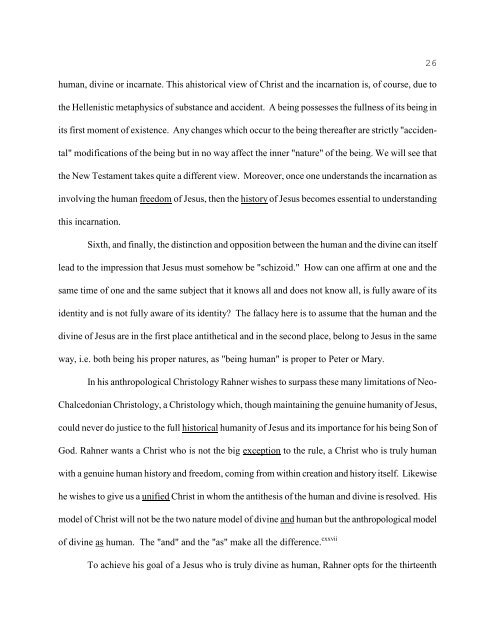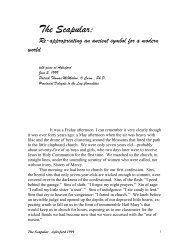Christocentrism of Charism – Buggert - CarmelStream
Christocentrism of Charism – Buggert - CarmelStream
Christocentrism of Charism – Buggert - CarmelStream
Create successful ePaper yourself
Turn your PDF publications into a flip-book with our unique Google optimized e-Paper software.
human, divine or incarnate. This ahistorical view <strong>of</strong> Christ and the incarnation is, <strong>of</strong> course, due to<br />
the Hellenistic metaphysics <strong>of</strong> substance and accident. A being possesses the fullness <strong>of</strong> its being in<br />
its first moment <strong>of</strong> existence. Any changes which occur to the being thereafter are strictly "acciden-<br />
tal" modifications <strong>of</strong> the being but in no way affect the inner "nature" <strong>of</strong> the being. We will see that<br />
the New Testament takes quite a different view. Moreover, once one understands the incarnation as<br />
involving the human freedom <strong>of</strong> Jesus, then the history <strong>of</strong> Jesus becomes essential to understanding<br />
this incarnation.<br />
Sixth, and finally, the distinction and opposition between the human and the divine can itself<br />
lead to the impression that Jesus must somehow be "schizoid." How can one affirm at one and the<br />
same time <strong>of</strong> one and the same subject that it knows all and does not know all, is fully aware <strong>of</strong> its<br />
identity and is not fully aware <strong>of</strong> its identity? The fallacy here is to assume that the human and the<br />
divine <strong>of</strong> Jesus are in the first place antithetical and in the second place, belong to Jesus in the same<br />
way, i.e. both being his proper natures, as "being human" is proper to Peter or Mary.<br />
In his anthropological Christology Rahner wishes to surpass these many limitations <strong>of</strong> Neo-<br />
Chalcedonian Christology, a Christology which, though maintaining the genuine humanity <strong>of</strong> Jesus,<br />
could never do justice to the full historical humanity <strong>of</strong> Jesus and its importance for his being Son <strong>of</strong><br />
God. Rahner wants a Christ who is not the big exception to the rule, a Christ who is truly human<br />
with a genuine human history and freedom, coming from within creation and history itself. Likewise<br />
he wishes to give us a unified Christ in whom the antithesis <strong>of</strong> the human and divine is resolved. His<br />
model <strong>of</strong> Christ will not be the two nature model <strong>of</strong> divine and human but the anthropological model<br />
<strong>of</strong> divine as human. The "and" and the "as" make all the difference. cxxvii<br />
To achieve his goal <strong>of</strong> a Jesus who is truly divine as human, Rahner opts for the thirteenth<br />
26



